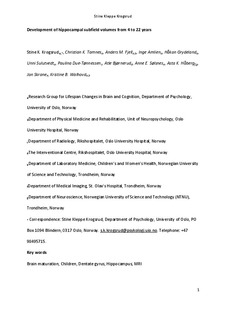Development of hippocampal subfield volumes from 4 to 22 years
Krogsrud, Stine Kleppe; Tamnes, Christian Krog; Fjell, Anders Martin; Amlien, Inge; Grydeland, Håkon; Sulutvedt, Unni; Due-Tønnessen, Paulina; Bjørnerud, Atle; Sølsnes, Anne Elisabeth; Håberg, Asta; Skrane, Jon Sverre; Walhovd, Kristine B
Journal article, Peer reviewed
Permanent lenke
http://hdl.handle.net/11250/2388875Utgivelsesdato
2014-06-30Metadata
Vis full innførselSamlinger
Sammendrag
The hippocampus supports several important cognitive functions known to undergo substantial development during childhood and adolescence, e.g. encoding and consolidation of vivid personal memories. However, diverging developmental effects on hippocampal volume have been observed across studies. It is possible that the inconsistent findings may attribute to varying developmental processes and functions related to different hippocampal subregions. Most studies to date have measured global hippocampal volume. We aimed to explore early hippocampal development both globally and regionally within subfields. Using cross-sectional 1.5T MRI data from 244 healthy participants aged 4-22 years, we performed automated hippocampal segmentation of seven subfield volumes; cornu ammonis (CA) 1, CA2/3, CA4/dentate gyrus (DG), presubiculum, subiculum, fimbria and hippocampal fissure. For validation purposes, seven subjects were scanned at both 1.5T and 3T, and all subfields except fimbria showed strong correlations across field strengths. Effects of age, left and right hemisphere, sex and their interactions were explored. Nonparametric local smoothing models (smoothing spline) were used to depict age-trajectories. Results suggested non-linear age functions for most subfields where volume increases until 13-15 years, followed by little age-related changes during adolescence. Further, the results showed greater right than left hippocampal volumes that seemed to be augmenting in older age. Sex differences were also found for subfields; CA2/3, CA4/DG, presubiculum, subiculum and CA1, mainly driven by participants under 13 years. These results provide a detailed characterization of hippocampal subfield development from early childhood.
